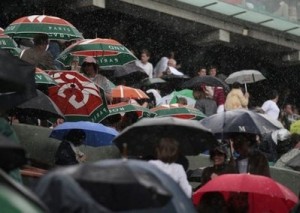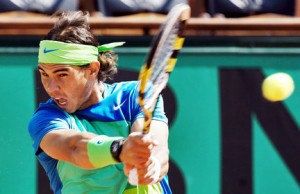Why Rafael Nadal May Be Watching the Weather
At the U.S. and Australian Opens, rain prompts an immediate stop in play–followed by the employment of the roof Down Under. Any tennis player dumb enough to play on wet asphalt is asking for a turned ankle, or maybe worse.
The grass of Wimbledon isn’t quite as risky in the rain, but you still won’t see players stay on it should the drops start falling; concrete or not, no one enjoys falling on their hind ends, especially when hundreds of thousands of dollars have been spent cultivating an image of them as great athletes.
The clay of Roland Garros is different. Sure, if the rain starts falling in buckets, the players will ask off of it, because no serious competitor likes playing in mud. If the downpour is light, though, play can continue with relatively low risk of the players hurting themselves.
A little rain, though, can make plenty of difference in what kind of conditions the players find on court.
Just ask Andy Murray. The Scotsman is no one’s clay court specialist, but he remains the game’s premier counterpuncher, utilizing speed, touch, and court sense to keep harder hitters off balance. That’s what he did to Rafael Nadal and Marin Cilic in Australia. That’s what he would have liked to have done to Tomas Berdych in their fourth round encounter on Sunday.
Sadly for the Scot, the weather was damp, and so was the court. In faster conditions he might have been able to deny the Czech–one of the heaviest hitters to ever play the game–the time needed to set up those forehands. With the moisture in the dirt, though, Murray couldn’t rush Berdych, who had plenty of time to hit 47 winners to the Scot’s 28.
You can also ask Andy Roddick, who doesn’t mind getting into long rallies, provided he can also win his share of free points on the serve. Forcing opponents to play long points on their service games, after all, can ramp up the pressure when Roddick is holding his own serve easily.
In round three, though, the wet bounce of Court Suzanne Lenglen denied Roddick all but four aces and left the American to win just 63 percent of his first serve points, a rather low rate for a guy whose first delivery regularly cracks 130 mph. As the rallies grew longer, Roddick’s opponent, Teimuraz Gabashvili, grew in confidence and, by the third set, Roddick was struggling to win any games at all.
Then, believe it or not, you can ask Rafael Nadal. Yes, moist clay does slow down the court, which ought to favor the consummate clay courter of this (and maybe any) generation. The trouble for the Spaniard is that the moisture in the clay steals the court’s usual bounce, which is no small matter for a guy whose primary weapon is a forehand that rotates the ball up to 5,000 times per minute.
This was evident in the first set he ever lost at Roland Garros, all the way back in 2005 against Sébastien Grosjean in the fourth round. When the match began, Nadal easily won the first set, as the 5’9” Frenchman struggled to return groundstrokes above his head. After taking set one 6-4, though, the rains came.
Grosjean, who has the advantage of hitting the forehand in a much more outward direction than the Spaniard, started capitalizing on some short balls (and a lot of French support) to take set two by a score of 6-3. Had they continued to play in the rain, we’ll never know whether the then 19-year-old Nadal, who had never won a major at the time, would have adjusted to those conditions.
We’ll never know because the rains fell harder, forcing a stoppage in play. The next day the two men came out in dryer conditions and Nadal won the third set 6-0. He then went on to win the title. He defended it successfully the next year and then, in two particularly dry seasons, he lost just one set in 2007, followed by none in 2008.
In between Roddick’s and Murray’s exits, Nadal faced off with Lleyton Hewitt of Australia in round three. The two have faced each other four times at this event in the last five years, with Nadal prevailing each time. Both men are baseliners with great speed and defense, but on clay the factor that has mattered most has been Nadal’s forehand spin and Hewitt’s lack thereof: the Australian has won just one set from the Spaniard in their RG encounters.
On Saturday, though, the Spaniard had trouble pulling away from Hewitt who, like Grosjean, is more comfortable stepping inside the court and driving the ball. Nadal’s extra bit of firepower saved him, though, and he managed to close out the match in straight sets: 6-3, 6-4, 6-3.
How will the rest of the tournament progress for the man from Majorca? The weather forecast may offer a clue. Should the rains continue, Nadal has passion and game enough to regain the RG crown he lost last year (which, by the way, had nothing to do with weather; he simply ran into a hot player who wouldn’t let him in the match).
But if the skies don’t clear up, the game’s top Spaniard will not run away with the title as he did in 2007 or ’08. He’ll have to prove his position as the heartiest competitor in the sport once more, because the weather itself will be his opponent.


I found your blog filled with great info.